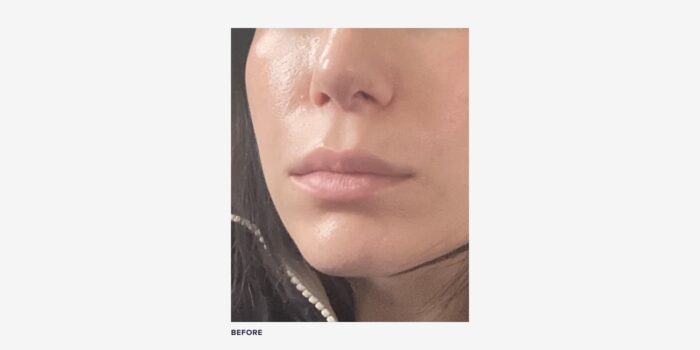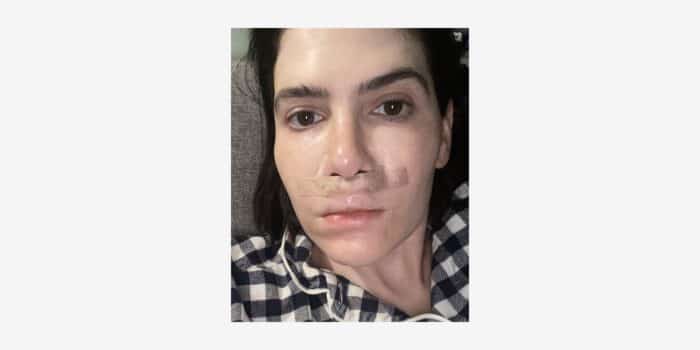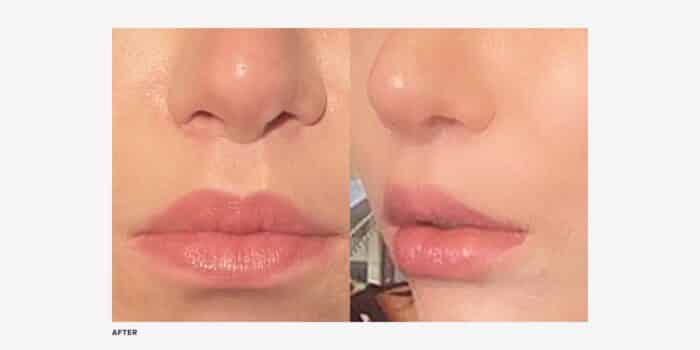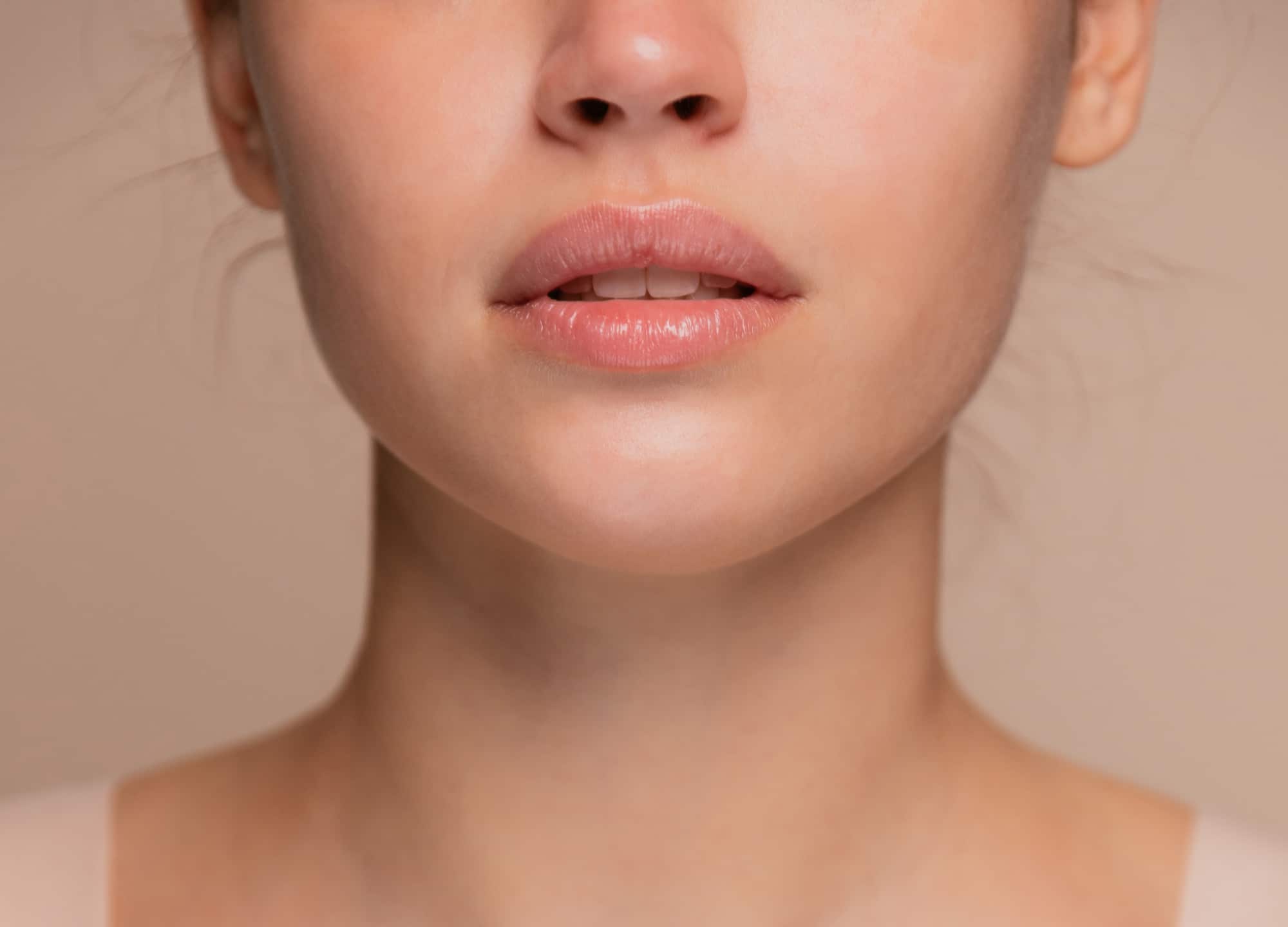As a gawky teenager during the early aughts, I spent hours splayed on my bed, reading Seventeen and Jane magazines, comparing my looks to those of celebrities and models like Paris Hilton, Jennifer Love Hewitt, and Kate Moss. Sure, I was tall and thin, but I worried that my prominent features looked misplaced on my too-small face. The one feature I liked about myself was my lips: full, with a defined Cupid’s bow. I would swipe on glitter lip gloss multiple times a day, admiring how the light reflected off them. As I got older, I struggled with low self-esteem and altered the features I didn’t like through cosmetic surgery. My lips remained the one link between the past versions of myself and the present.
A few years ago, I opted to finally correct a botched rhinoplasty I’d had done in my early 20s that had left me with an asymmetric profile and further chipped away at my self-esteem. Although I had previously sworn off major cosmetic surgeries because they exacerbated my feelings of body dysmorphia instead of alleviating my misery, I decided to have one final correction done to my nose before I moved forward with my life and left body modifications firmly in the past. I researched doctors and became familiar with the long recovery for revision rhinoplasty. Finally, I settled on a celebrity plastic surgeon in Beverly Hills, California, known for his impressive results on social media. His affect was cold, and he replied to any concerns I raised with clipped responses. No matter, I thought. I chose to undergo surgery with him for the quality of his work—not his bedside manner.
When the surgeon finally removed my cast in his office a few days after my procedure, I was relieved to see my new symmetrical nose, which I could make out beneath all the swelling that made me look like a days-old piece of fruit. Despite my bruised face, I felt comfortable in my skin for the first time since right before I hit puberty, when my mind became my own worst enemy. For those few seconds, I felt free, unshackled from intrusive thoughts about my looks. That all vanished when I looked at the rest of my face, peering into the handheld mirror as I went over the results with the surgeon. As my eyes traveled past my newly altered nose, I realized that my lips now seemed to hang down like a curtain over my teeth when I spoke. There was something off-putting about my new look that I couldn’t put into words. I wanted to cry, but I said nothing as a voice in my head berated me for having chosen to go under the knife yet again. I told the doctor there was something strange about my lips, but nothing more.

I was reassured that this was simply a temporary side effect of the “tip plasty” I had undergone and that my original smile would return. I had to look at old photographs to make sure my mind wasn’t playing tricks on me; my lips had changed significantly since the surgery. I stopped smiling and became insecure about how my mouth moved and looked when I talked. I kept reading about how “tooth show” was associated with youthfulness in women, and I tried facial exercises I saw demonstrated on YouTube, to coax my lips back into their original position.
Over the next three years, I trained myself to communicate happiness with an unnatural, tight-lipped grin. After numerous visits with my plastic surgeon, who continued to insist that my original smile would return (to no avail), he finally said, “You should consider getting a lip lift. I think you’ll really love the result.” Disheartened and disappointed in the doctor, I returned home to New York to make peace with my new face and, yet again, live with the consequences of my decision to have plastic surgery.
Last year, as I continued looking for solutions for my smile, I started reading more about how this old cosmetic procedure had gained momentum with a younger audience. Invented in the 1980s, the lip lift enlarged older patients’ lips. The scarring visible after various procedures had previously caused many plastic surgeons to abandon it. Yet recent advances to the stitching and placement of the scar employed during a lip lift have made the “bullhorn” version of a lip lift popular with patients of all ages. During this procedure, a bullhorn-shaped piece of skin is removed from beneath the nose, to shorten the length of the philtrum (the area between the bottom of the nose and the top of the lip). Since the scar is hidden beneath the nasal sill, it’s said to be almost invisible and can be covered with makeup when healed. In addition, the procedure is generally performed under local anesthesia, keeping risks and costs lower.
While most patients opt to undergo a lip lift procedure to correct a long philtrum and augment their lips, I wondered if the procedure could specifically improve the lack of tooth show I had following revision rhinoplasty. According to a 2021 study published in the British Journal of Oral and Maxillofacial Surgery, after reviewing the medical records of 67 patients who’d undergone open rhinoplasty, lip length increased in 46 subjects. I had been so preoccupied with correcting the imperfection I saw with my nose that I never considered how tweaking it could impact the rest of my face. I discovered that many patients experienced unfavorable changes to the length of their philtrum and their natural tooth show after surgery on the nose, despite finding few resources explaining the phenomenon online.
I scoured the internet, reading patient reviews and comparing photos, before deciding to get a consultation with NYC-based board-certified plastic surgeon Dr. Gary Linkov. Although Dr. Linkov could not promise to give me back my original smile, he was confident that he could substantially improve my appearance by correcting the length of my philtrum during surgery and increasing my tooth show. He estimates that 15–20% of his lip lift patients come in for the same issue I was experiencing. I decided that getting close to my original smile was worth any inherent risk. I set a date for surgery and held my breath.
On the day of my procedure, I was unusually nervous, fearing that there would be unwanted changes to my appearance that I hadn’t planned for. But after taking preoperative photos with Dr. Linkov and discussing my goals, I felt more relaxed and better about my decision. Dr. Linkov measured my philtrum, 17 millimeters in length, and decided it would be best to bring me down to a shorter, more aesthetically pleasing 12 millimeters. I was prepped for surgery and injected with a local anesthetic on the operating table, which felt like painful pinches; then the base of my nose and lip went numb. After that, Dr. Linkov and his assisting nurse talked to me as they proceeded to remove the skin from underneath my nose, cauterize the wounds, and stitch together the incisions as I lay awake. During the entire process, I did not feel any pain. Afterward, a dressing was placed over my lip and I was sent home to recover.

Although I tried to avoid the mirror after arriving home, I caught a glimpse of myself—and someone I didn’t recognize stared back at me. I saw a very swollen protruding upper lip and a nose resembling a pig snout, which made me feel anxious; I tried to avoid reflective surfaces after that. I was instructed to eat liquid or soft foods and limit moving my mouth by not speaking for the next two weeks. This was the most challenging part of my recovery, as the pain was minimal and something I could manage by icing on and off and sleeping with my head in an elevated position. Since I work from home, I recovered over the weekend and got back to my routine by Monday. I avoided strenuous activity and the gym for a full three weeks.
I’m now just shy of two months since the surgery. Recovery has been easy, now that I can speak and eat freely. While changes after the first month were more dramatic as most of the swelling and bruising on my lip disappeared, I’ve noticed subtle changes like a resolution in the nasal flare and continued improvement with my lips settling into their final position. One issue I did not anticipate was that my lips have become a lot more chapped during recovery. Since the lips are slightly turned out during this procedure, some of the lip tissue that used to be internal is now exposed to air. I’m diligent about applying emollients to the lips and a daily scar gel beneath my nose, to help move the process along.
I’m happy to report that my tooth show is visible when my lips are slightly parted, and although I am still somewhat stiff (and healing), my original smile is about 90% there. However, learning to live with the scar has been an adjustment. Dr. Linkov assures me that it will continue to fade over the next few weeks, with suitable results at three months and final results for the procedure and scar noticeable at one year. Being patient during the healing process has been one of my biggest hurdles. Although the recovery from a lip lift may not be as impairing as other cosmetic procedures, patients should be prepared for slow and unexpected changes to their faces.

At times, it has felt uncomfortable as the severed nerves on the face regenerate. Accepting aesthetic changes was difficult until my brain caught up to what it saw. Although my lips weren’t thin to begin with, the lip lift has further accentuated their shape and given me back the lips of my teens. At 36, I finally have a pronounced Cupid’s bow, which is better defined than before the revision rhinoplasty, and I don’t need to worry about getting filler, since I’m thrilled with their new size and shape. I’ve also rediscovered the joys of applying lipstick to my mouth without feeling self-conscious about how it might look if I smile.
According to some scientific research, bee-stung lips convey sensuality and youthfulness and send a visual cue that a female is fertile. Perhaps that’s why they’re more popular than ever; women of all ages are pursuing fuller lips. I’ve seen friends receive lip filler, with varying degrees of success. Knowing that my lips will remain naturally plump for the foreseeable future (until the aging process catches up with me), without worrying about possible complications from future filler, has given me some peace of mind.
By educating myself on what to expect during this surgery, I could achieve realistic expectations instead of hoping that I would come out of this with Angelina Jolie’s lips. “You’re going to have your own [lip lift] results. A lot of it will depend on your starting anatomy,” explains Dr. Linkov.
While I’m no stranger to cosmetic surgery, I’m mindful that undergoing a procedure on the face is a personal decision that no one should enter into lightly, since recovery can include both physical and emotional symptoms. Still, I’m relieved that I found a procedure that could give me my smile and self-esteem back.











